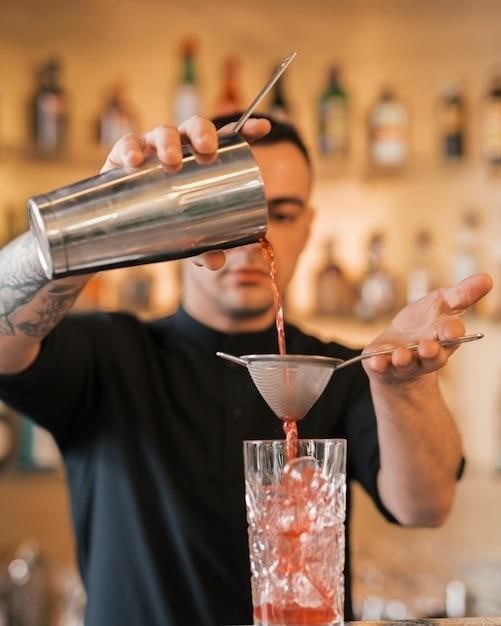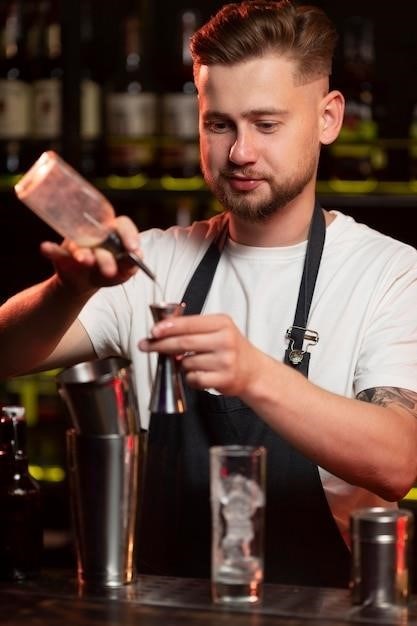The Bartender’s Guide⁚ A Comprehensive Resource
This comprehensive guide is designed to be your one-stop shop for all things bartending. Whether you’re a seasoned professional or just starting out, this guide will provide you with the information and skills you need to succeed. From understanding the basics of mixology to mastering wine terminology, this guide covers everything you need to know to become a successful bartender.
Understanding the Basics
Before diving into the exciting world of bartending, it’s crucial to grasp the fundamental concepts that form the foundation of this craft. Think of it as building a strong base for your bartending journey. First and foremost, a bartender’s primary role is to serve drinks responsibly and professionally. This involves knowing your drinks, your customers, and the legal regulations surrounding alcohol service. It’s not just about mixing and shaking; it’s about creating a welcoming and enjoyable experience for your guests.
A key aspect of understanding the basics is familiarizing yourself with the different types of alcoholic beverages. You need to know the difference between whiskey and bourbon, the origins of various wines, and the unique characteristics of different spirits. This knowledge will enable you to recommend drinks that align with your customers’ preferences and enhance their experience.
Equally important is understanding the different types of drinks and their preparation methods. From classic cocktails to modern concoctions, knowing the ingredients, proportions, and techniques used to create each drink is essential. This will allow you to confidently prepare any order and impress your customers with your expertise. A grasp of basic mixing techniques, such as shaking, stirring, and muddling, is also crucial.
Finally, remember that bartending is more than just pouring drinks; it’s about providing excellent customer service. Building rapport with your guests, engaging in conversation, and anticipating their needs will create a positive and memorable experience that keeps them coming back for more.
Essential Bartending Skills
Beyond the basics, mastering certain skills is essential for success in the bartending world. These skills go beyond just knowing your drinks; they encompass the art of customer interaction, efficient service, and a touch of bar magic.
First and foremost, you need to master the art of speed and efficiency. A busy bar demands a bartender who can work quickly and accurately. This involves being able to take orders, mix drinks, and serve customers without missing a beat. Practice your pouring techniques, learn how to multitask, and streamline your workflow to ensure smooth service.
Impeccable customer service is paramount. A good bartender is a skilled communicator, able to build rapport with customers, anticipate their needs, and create a welcoming atmosphere. Learn to remember orders, engage in friendly conversation, and provide recommendations based on individual preferences. A positive and approachable demeanor can make all the difference in a customer’s experience.
A keen eye for detail is crucial. From meticulously crafting cocktails to ensuring glasses are spotless, attention to detail enhances the overall experience. Learn to recognize the subtle nuances of a well-made drink and strive for consistency in your craft. This meticulousness reflects your professionalism and sets you apart as a skilled bartender.
Finally, don’t underestimate the power of a positive attitude. A genuine smile, a friendly greeting, and a genuine interest in your customers can transform a simple drink into a memorable experience. Remember that bartending is about creating a positive atmosphere and leaving a lasting impression on your guests.
The History of Alcohol
The history of alcohol is a journey through time, spanning millennia and continents, interwoven with culture, innovation, and even controversy. It’s a story that goes beyond the mere consumption of drinks; it reveals the evolution of human society, its rituals, and its relationship with the intoxicating elixir.
The earliest evidence of alcoholic beverages dates back to ancient Mesopotamia, where archaeologists have unearthed remnants of beer production from around 7000 BC. This discovery suggests that brewing techniques were already well established in this region, marking a significant milestone in the history of alcohol.
As civilizations developed, so too did their relationship with alcohol. In ancient Egypt, beer was a staple beverage, consumed by all classes, and even used in religious ceremonies. Wine, originating in the Middle East, gained popularity in the Mediterranean region, becoming an integral part of Roman culture and feasting.
The Middle Ages witnessed the rise of distilled spirits, a revolutionary development that brought forth new forms of alcoholic beverages, such as whiskey, brandy, and gin. This era also saw the emergence of taverns and pubs, creating social hubs where people gathered to drink and socialize.
The modern era brought about advancements in distillation techniques, leading to a wider variety of spirits and cocktails. The cocktail culture of the 19th and 20th centuries flourished, fueled by the popularity of bars and the rise of mixology as an art form.
Today, the history of alcohol continues to evolve, driven by innovation, trends, and evolving tastes. From craft spirits to artisanal cocktails, the world of alcohol is a constantly evolving landscape, offering a glimpse into the past while embracing the future.
The Art of Mixology
Mixology, the art and science of crafting cocktails, is a captivating world that blends creativity, precision, and a deep understanding of flavors. It’s more than just mixing drinks; it’s about creating a symphony of tastes and textures, an experience that tantalizes the palate and awakens the senses.
At its core, mixology is about balance and harmony. It involves carefully selecting ingredients, considering their individual characteristics and how they will interact when combined. A skilled mixologist understands the nuances of flavor profiles, the subtleties of sweetness, acidity, bitterness, and the role of spices and aromatics.
The art of mixology also encompasses technique. Mastering the art of shaking, stirring, muddling, and layering ingredients is crucial for achieving the desired consistency and presentation. Knowing when to use a shaker for a chilled and frothy drink, or a stirring spoon for a smooth and elegant cocktail, is essential for creating a perfect libation.
Beyond the technical aspects, mixology is infused with creativity. Experimenting with different flavor combinations, exploring new ingredients, and infusing classic cocktails with a personal touch are all hallmarks of a skilled mixologist.
The world of mixology is a dynamic and ever-evolving field. As new spirits emerge, and culinary trends shift, mixologists constantly push boundaries, creating innovative cocktails that redefine the art of drinking. Whether it’s a classic Old Fashioned with a modern twist or an entirely original concoction, mixology continues to captivate and inspire.

Understanding Bar Terms
Navigating the world of bartending can be a bit overwhelming, especially when you’re faced with a barrage of unfamiliar terms. But fear not, understanding bar terminology is key to becoming a confident and competent bartender. From classic cocktails to specific techniques, a grasp of these terms will help you navigate the bar with ease and impress your customers.
Terms like “neat,” “on the rocks,” “up,” and “straight up” refer to how a drink is served. “Neat” means a drink served without ice, while “on the rocks” signifies a drink served with ice. “Up” and “straight up” both indicate a drink that is shaken or stirred with ice and then strained into a chilled glass, leaving the ice behind.
Then there are terms specific to ingredients and preparation, such as “muddle,” “garnish,” and “rim.” “Muddling” involves gently crushing ingredients like herbs, fruits, or sugar to release their flavors. “Garnish” refers to the decorative element added to a drink, be it a lemon twist, a cherry, or a sprig of mint. “Rim” refers to the process of coating the edge of a glass with sugar, salt, or other ingredients to enhance the flavor and presentation.
Knowing these terms is not only helpful for understanding orders and recipes but also for communicating effectively with other bartenders and customers. It allows you to speak the language of the bar, demonstrating your knowledge and expertise.
Mastering Wine Terminology
Wine can be a complex and fascinating world, with a rich vocabulary that can seem intimidating to newcomers. But mastering wine terminology is essential for any bartender, as it allows you to confidently recommend wines, understand customer preferences, and navigate conversations about this beloved beverage.
First, it’s important to understand the basic terms describing wine types, such as “red,” “white,” “rosé,” and “sparkling.” Red wines are made from red grapes, white wines from white grapes, rosé wines from red grapes but with shorter skin contact, and sparkling wines are characterized by their bubbles. Beyond this, terms like “dry,” “medium,” and “sweet” describe the level of sweetness in a wine.
Then there are terms describing flavor profiles, such as “fruity,” “earthy,” “spicy,” and “oaky.” Fruity wines have prominent fruit notes, while earthy wines possess aromas of soil and mushrooms. Spicy wines have hints of pepper, cinnamon, or cloves, while oaked wines have notes of vanilla, toast, or caramel due to aging in oak barrels.
Finally, terms like “tannin,” “acidity,” and “body” describe the wine’s structure. Tannins, found in red wines, contribute to astringency and bitterness. Acidity adds tartness and freshness. Body refers to the wine’s weight and fullness on the palate. Understanding these terms helps you guide customers towards wines that best suit their tastes and preferences.
Essential Bar Glassware
Behind the bar, glassware is more than just something to hold a drink. It plays a crucial role in enhancing the visual appeal, temperature control, and overall drinking experience. Understanding the different types of glassware and their appropriate uses is essential for any bartender.
The classic Martini glass, with its conical shape and stem, is designed to showcase the clarity and brilliance of cocktails like Martinis and Margaritas. The rocks glass, also known as an old fashioned glass, is sturdy and wide-mouthed, perfect for serving cocktails on the rocks or neat. The highball glass, tall and cylindrical, is ideal for mixed drinks with ice and soda, such as Gin and Tonics and Mojitos.
The wine glass, with its distinctive bowl and stem, enhances the aromas and flavors of different wines. The red wine glass has a wider bowl to allow for more oxygenation, while the white wine glass has a smaller bowl to preserve the wine’s chill. The champagne flute, tall and narrow, is designed to showcase the bubbles and delicate aroma of champagne.
Other essential glassware includes the shot glass, for serving strong spirits in small portions, and the pint glass, for serving beer. Investing in a quality set of glassware is an essential step in creating a professional and inviting bar environment.
Essential Bar Tools
Behind the bar, the right tools are essential for crafting perfect cocktails and ensuring smooth service; From the classic shaker to the specialized muddler, each tool plays a vital role in creating a delightful drink.
The cocktail shaker is a must-have for any bartender. It’s used to mix and chill ingredients, creating a smooth and well-balanced cocktail. The shaker comes in two main types⁚ the Boston shaker, which consists of two parts, a metal tin and a glass, and the Cobbler shaker, which is a single unit with a lid.
The bar spoon is another essential tool, used for stirring cocktails, layering ingredients, and measuring small amounts of liquid. The muddler is a specialized tool used to crush herbs, fruits, and spices, releasing their flavors into the drink.
Other essential tools include the jigger, for precise measurements of liquor, the strainer, for separating ice and fruit from the cocktail, and the bottle opener, for opening beer bottles. Investing in a good quality set of bar tools is a worthwhile investment for any bartender, ensuring professional results and a smooth workflow.
Becoming a Bartender
Embarking on a bartending career is an exciting journey that involves more than just mixing drinks. It’s about creating a welcoming atmosphere, engaging with customers, and mastering the art of hospitality. The path to becoming a bartender can be paved with various routes, each offering its own unique advantages.
One common path involves gaining experience through on-the-job training. This hands-on approach allows you to learn the ropes directly from experienced bartenders, mastering techniques and gaining valuable insights into the industry; Another option is to enroll in a bartending school, which offers structured training, covering everything from basic mixology to advanced cocktail techniques, customer service, and industry regulations.
Regardless of the chosen route, developing strong communication and interpersonal skills is crucial. Being able to interact with customers, build rapport, and provide exceptional service are key ingredients to a successful bartending career. Additionally, staying updated on current trends, popular cocktails, and evolving customer preferences will enhance your skills and keep you at the forefront of the bartending scene.
Bartending Salaries
The allure of bartending often lies in its potential for earning a good income. While the actual salary can vary significantly depending on factors like location, experience, bar type, and tips, bartenders have the potential to make a comfortable living. The general consensus is that bartenders can earn a decent income, especially in busy bars or upscale establishments.
Tips play a significant role in a bartender’s overall earnings. In many places, tips constitute a substantial portion of their income. However, it’s important to remember that tips can fluctuate based on factors like the day of the week, the time of year, and the overall bar’s popularity. Experienced bartenders often develop strategies to maximize their tips, including providing exceptional service, building a loyal clientele, and understanding customer preferences.
In addition to tips, some bartenders may receive a base hourly wage, which can vary depending on the state’s minimum wage laws and the bar’s policies. Overall, a bartending career can offer a financially rewarding path, especially for those who excel in customer service, have a knack for mixing drinks, and are comfortable working in a fast-paced environment.
Bartending Tips and Tricks
The art of bartending goes beyond just knowing recipes and pouring drinks. Experienced bartenders possess a wealth of tips and tricks that elevate their craft and contribute to a positive customer experience. These tips are often passed down through generations of bartenders and are essential for ensuring efficient service, maintaining a smooth workflow, and keeping patrons happy.
One of the most crucial tips is to prioritize organization. A well-organized bar is a key to efficiency. Keep your tools and ingredients readily accessible, maintain a clean and clutter-free workspace, and practice quick and precise pouring techniques. This not only speeds up service but also creates a more professional and inviting atmosphere. Another important tip is to learn the art of conversation. Engaging with customers, understanding their preferences, and building rapport can enhance their experience and lead to repeat business.
Remember, the goal is to create a memorable and enjoyable experience for every customer. Beyond the technical aspects, a genuine smile, friendly demeanor, and a willingness to go the extra mile can make a big difference. By mastering these tips and tricks, you’ll not only become a more efficient bartender but also a more engaging and memorable one, leaving a lasting positive impression on your patrons.



Leave a Reply
You must be logged in to post a comment.